
1880s NYC: Fostering Diversity, Innovation & Prosperity in The Gilded Age
The 1880s, during the Gilded Age, marked a transformative period for New York City, defined by significant advancements in technology, infrastructure, and culture. This era was highlighted by the completion of the Brooklyn Bridge in 1883, an engineering marvel connecting Manhattan and Brooklyn, symbolizing the city’s innovation and ambition. In 1886, the unveiling of the Statue of Liberty further solidified New York City’s status as a global symbol of hope and opportunity, attracting visitors from around the world.
This decade also saw the rapid expansion of New York City’s transit system, with the introduction of elevated railroads revolutionizing urban transportation. The early planning of the New York City Subway, destined to become the city’s transportation backbone, reflected visionary urban planning. The 1880s were also marked by significant demographic shifts, as a surge of immigrants diversified the city’s communities. This influx brought new ideas and traditions, enriching New York City’s cultural landscape.
The challenges of rapid urbanization during this period led to a push for improved public health, better housing conditions, and effective governance, resulting in reforms that shaped the city’s future. The 1880s were foundational in establishing New York City as a leader in urban development and social reform, paving the way for its growth into the 20th century.
In summary, the 1880s, a critical era of the Gilded Age, were a time of dynamic change and growth for New York City. The era’s architectural achievements, cultural diversity, and urban innovations played a crucial role in shaping the city’s identity as a modern metropolis. The legacy of this decade continues to influence the character and trajectory of New York City, making it a key chapter in the history of one of the world’s most iconic cities.
Timeline of New York City’s History in the 1880s
Discover surprising historical facts about The City That Never Sleeps—explore fun, educational insights into its history, population, iconic landmarks, and more, perfect for students, history enthusiasts, and anyone curious about NYC’s rich heritage.
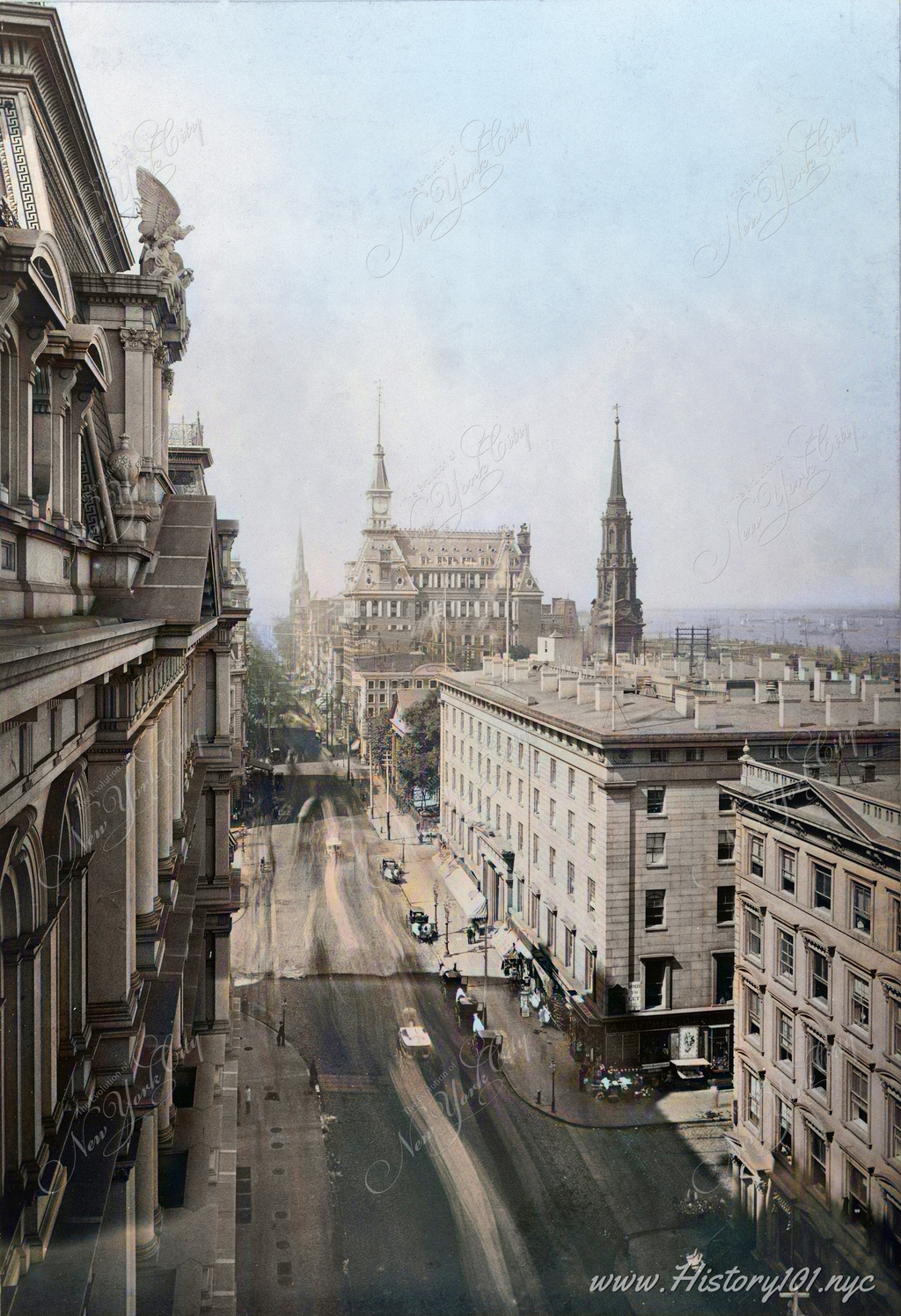
1880: Broadway in Focus: Insights into New York City's Historical Evolution
Explore Charles Pollock's 1880 photograph of Broadway, offering a unique view on New York's architectural diversity and urban development
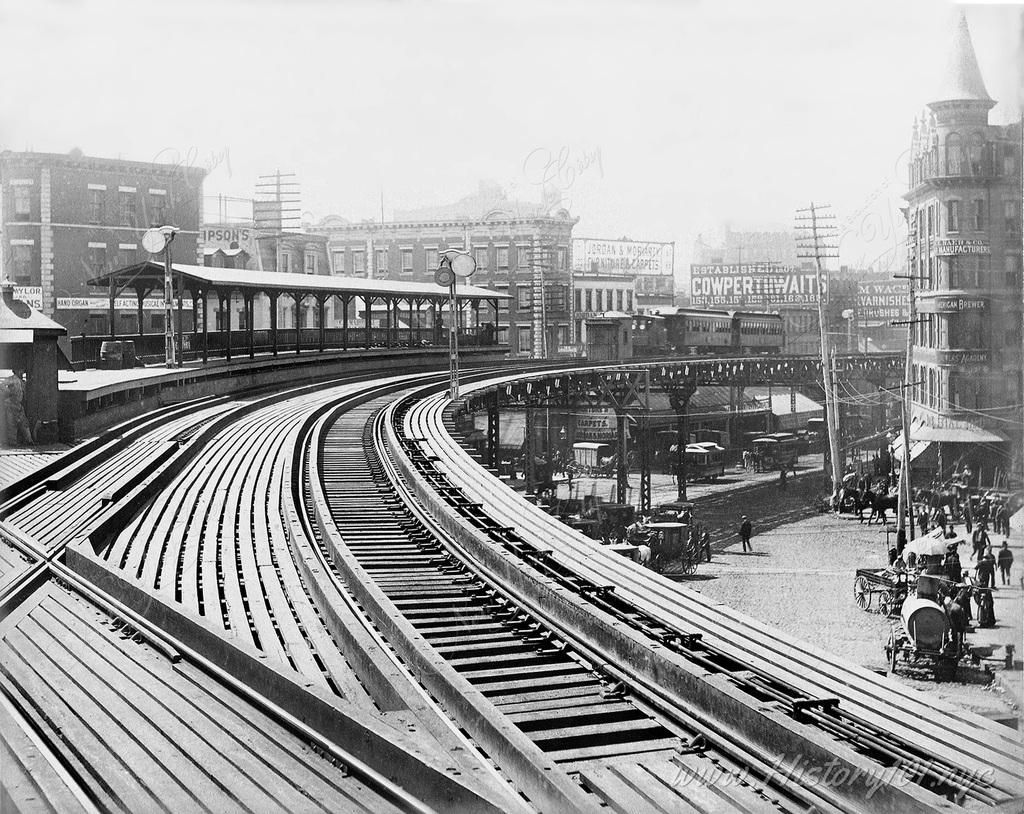
1880: New York Elevated Railway
A view looking down elevated railroad tracks. A train is approaching around the curve.
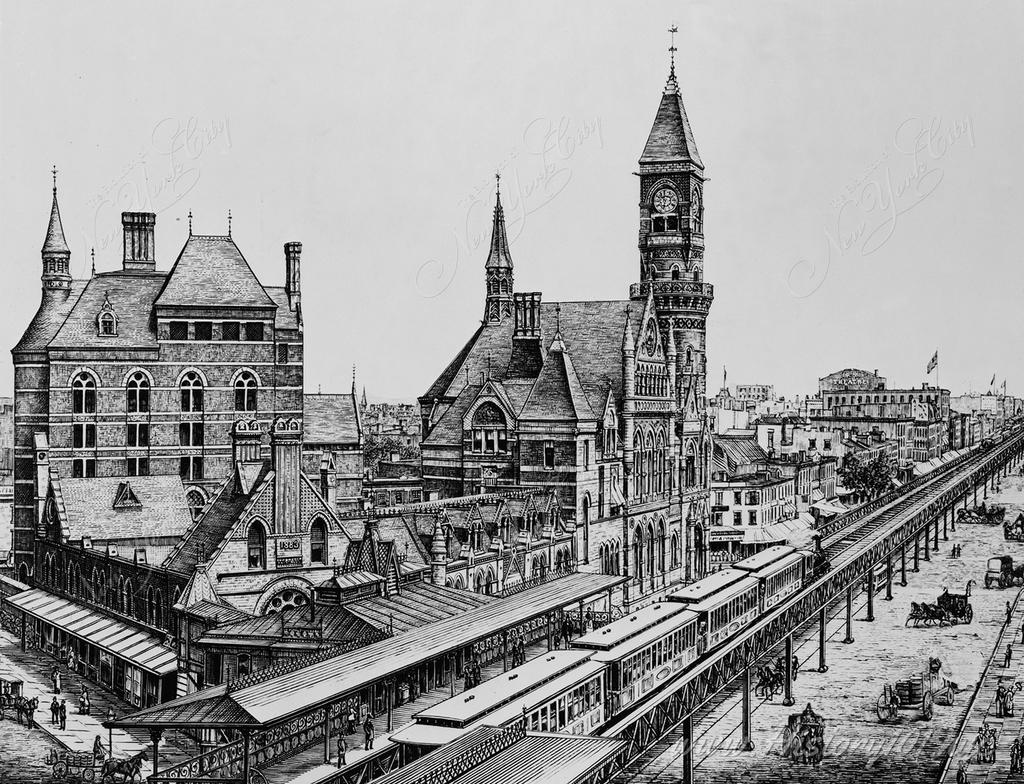
1880: Jefferson Market
View north along Sixth Avenue shows the Third Judicial District Courthouse, 425 Avenue of the Americas, currently known as Jefferson Market.
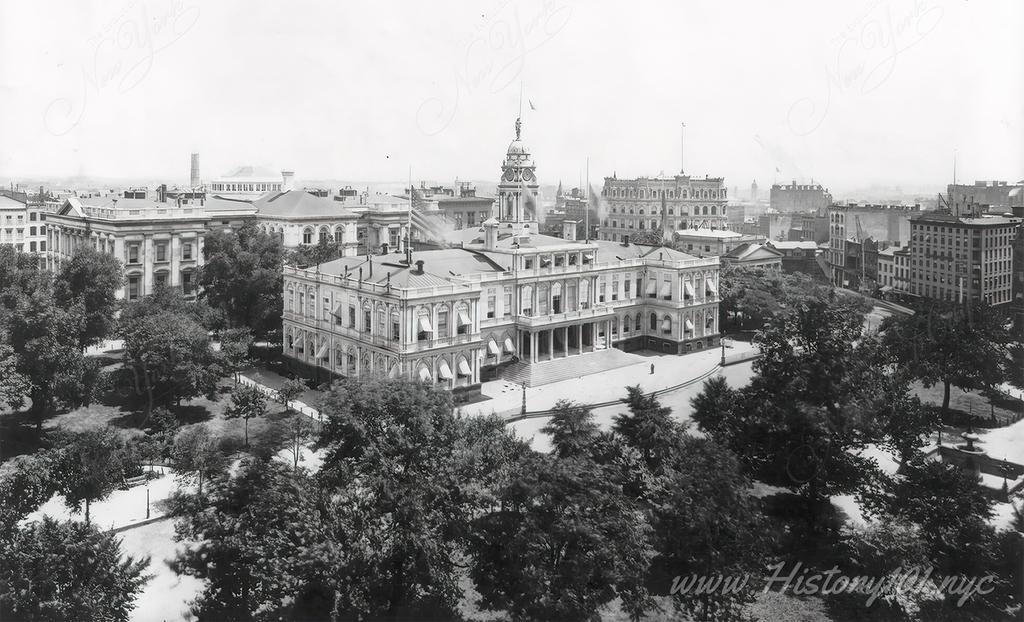
1880: New York City Hall
Aerial photograph of City Hall with its neighborhood buildings and surrounding park in downtown Manhattan.
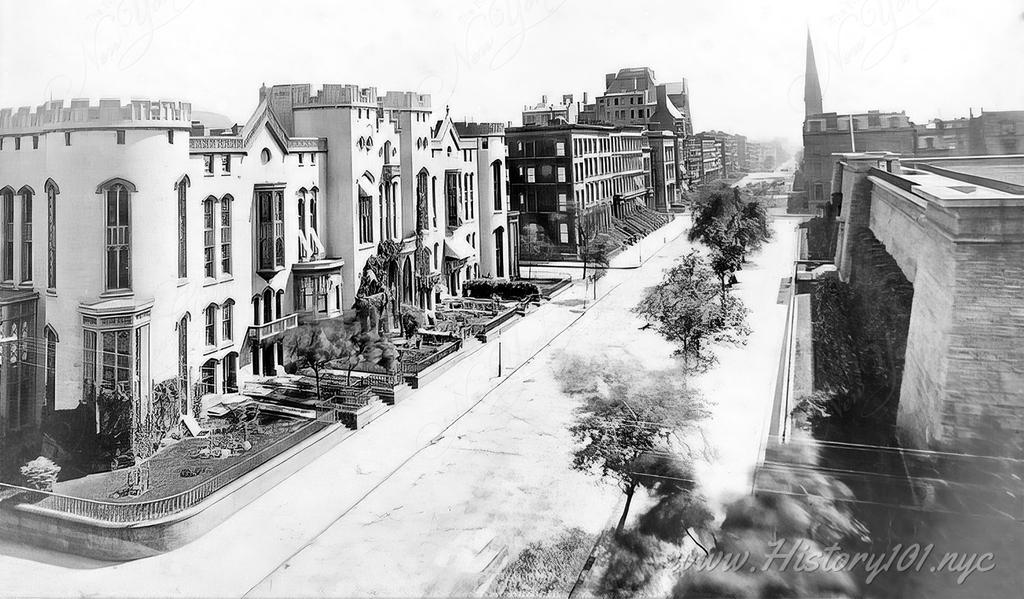
1880: Croton Reservoir Looking South
Aerial photograph of Fifth Avenue looking south with Rutgers Female College on left and Croton Reservoir on right.
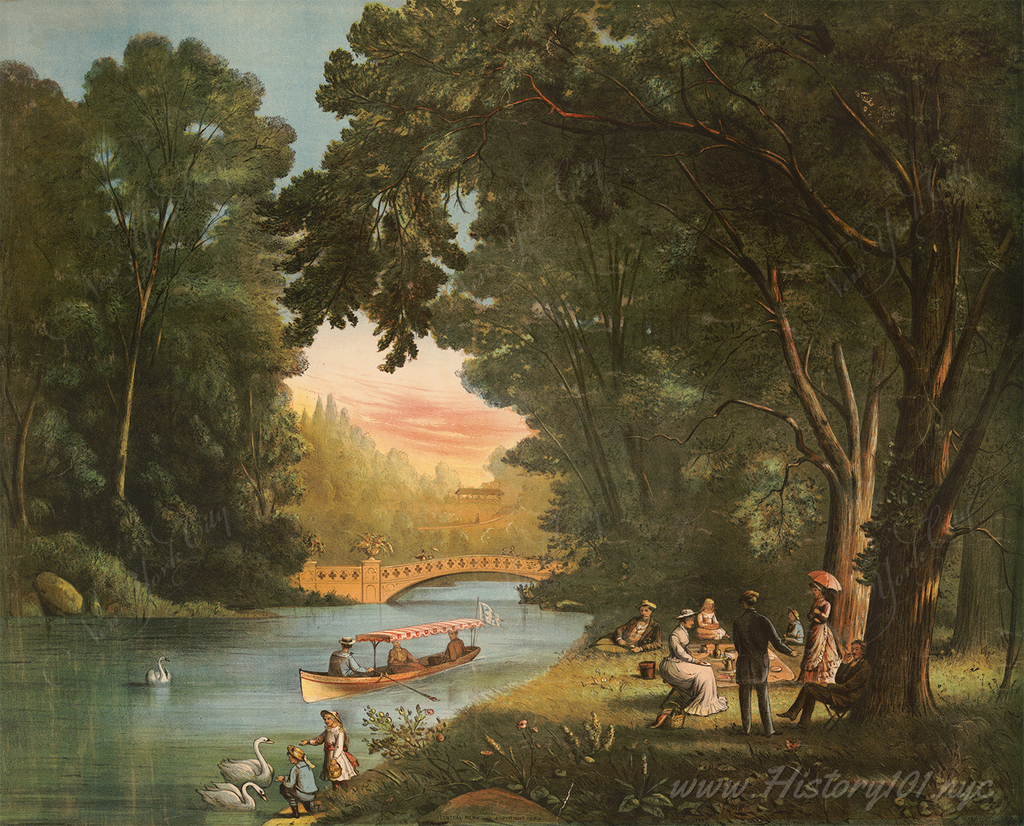
1882: Central Park
This chromolithograph dates back to 1882 and captures a picturesque scene of Central Park in New York City.
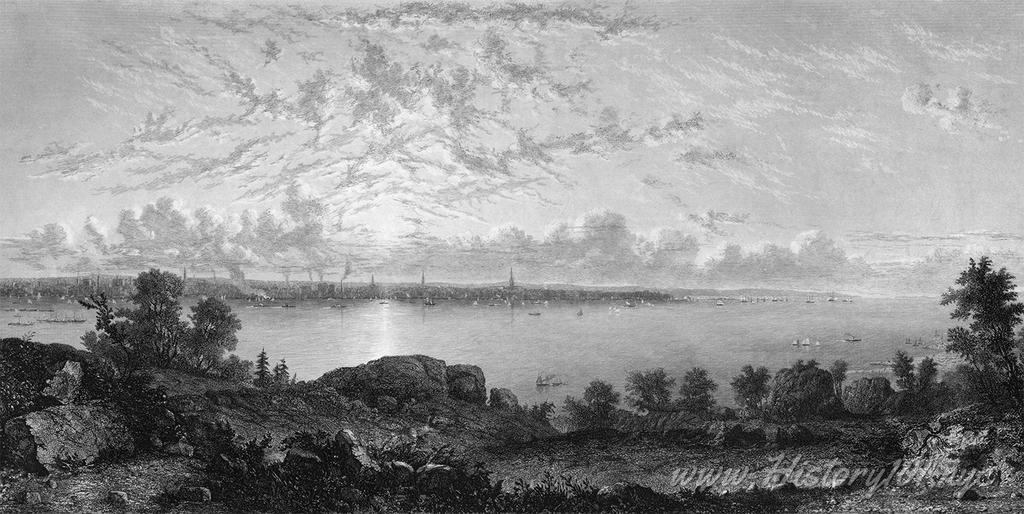
1882: Manhattan Skyline from Jersey City
An illustration of downtown Manhattan from Jersey City, long before the era of skyscrapers.
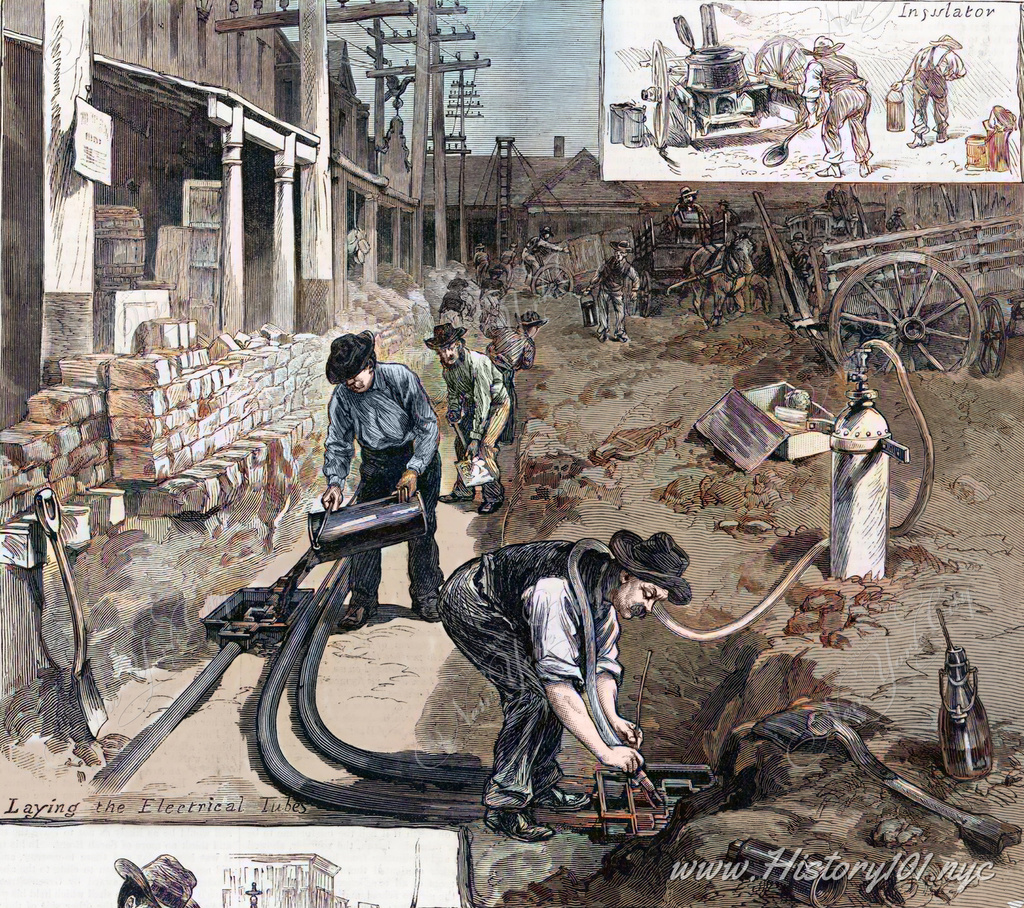
1882: Laying the tubes for Electric Wires in The Streets of New York City
In 1882, amidst the bustling streets of New York City, a transformative chapter in history unfolded as the intricate network of electrical tubes for the revolutionary electric light system was meticulously laid.
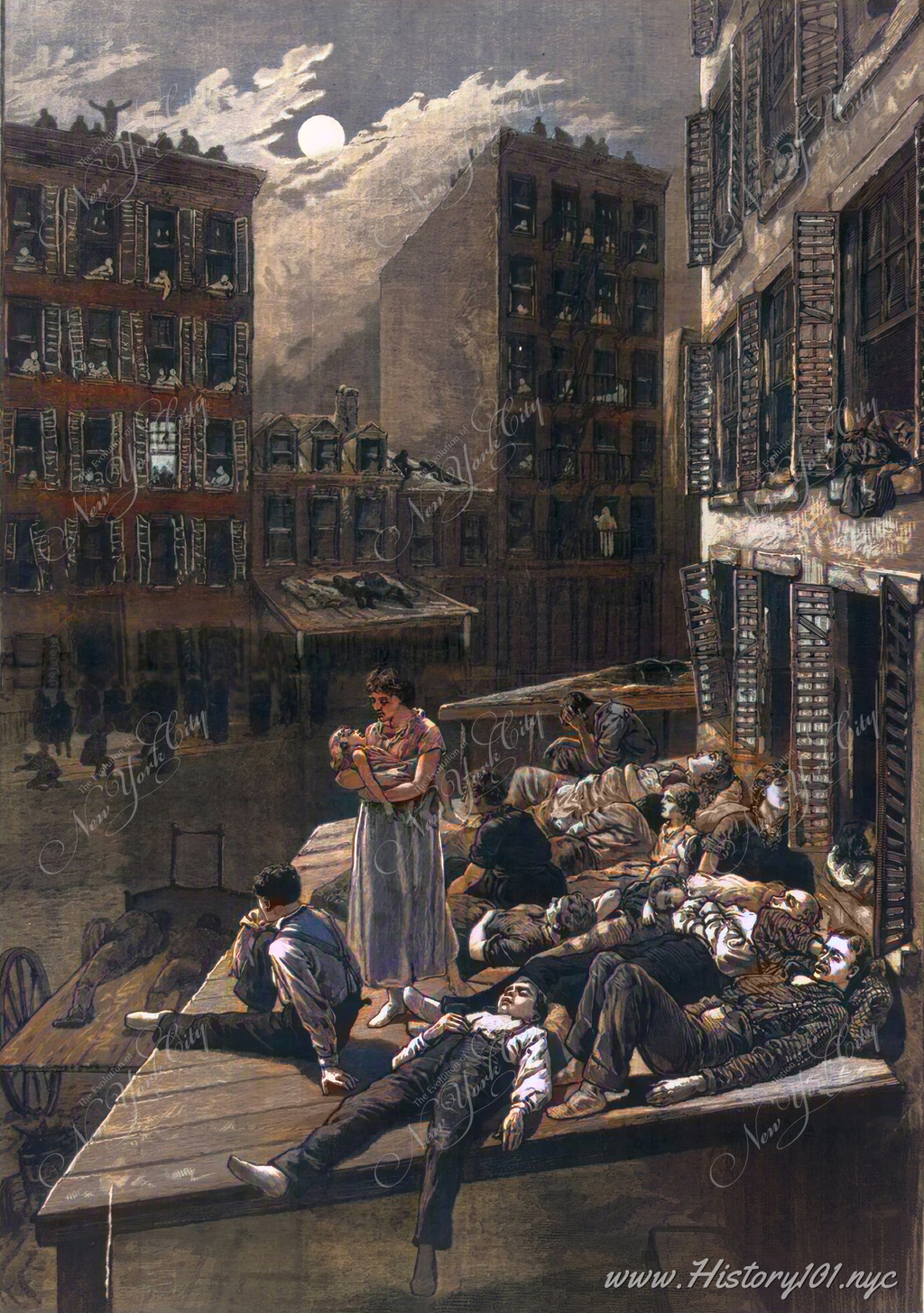
1882: Heatwave in NYC: A Summer Night Scene with Residents Sprawled Across Rooftops
Discover the 1882 NYC heatwave's impact on tenement districts, showcasing families' resilience and communal spirit on rooftops without modern comforts
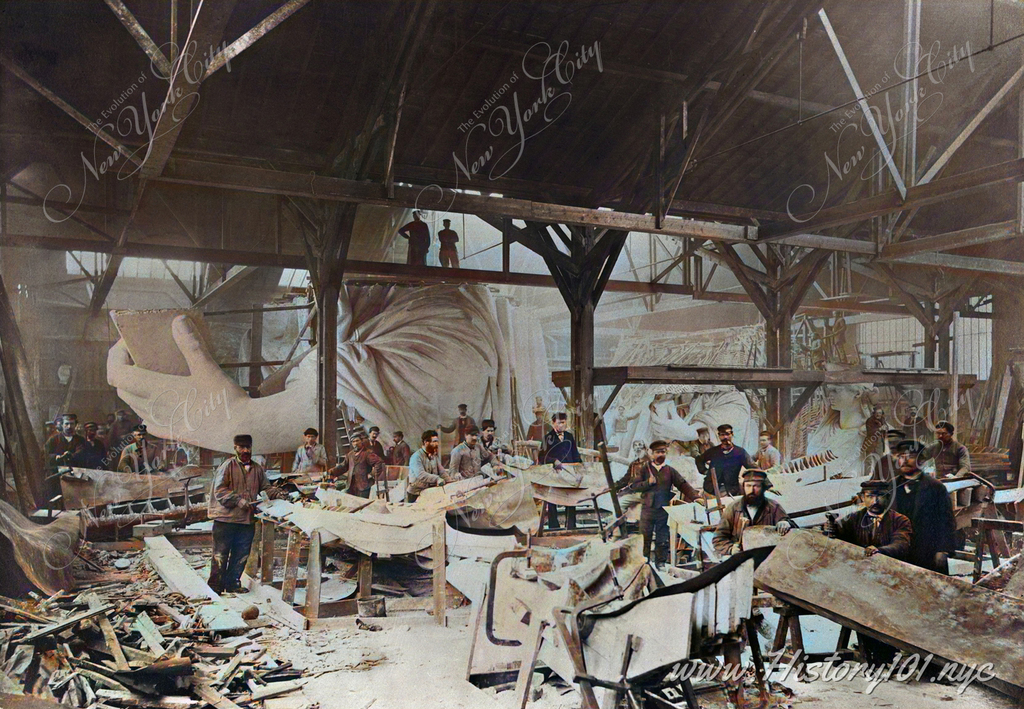
1882: The Statue of Liberty's Historic Journey: From Paris to New York (1875-1886)
Explore the Statue of Liberty's journey from a 1875 French workshop to its 1886 dedication in NYC, showcasing international craftsmanship
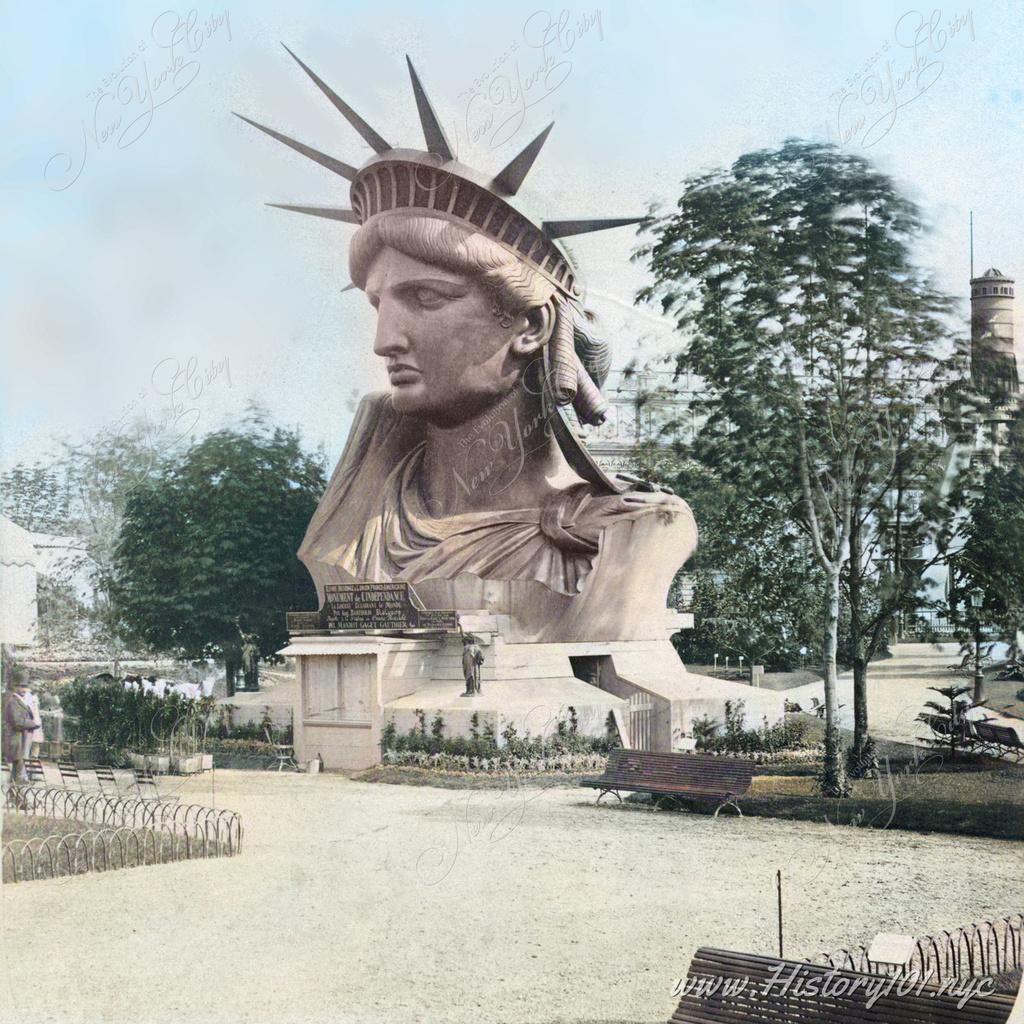
1883: Statue of Liberty Head on Display in Paris
In 1878, at the Exposition Universelle in Paris, a remarkable sight greeted visitors: the head of the Statue of Liberty proudly on display at Champ-de-Mars.
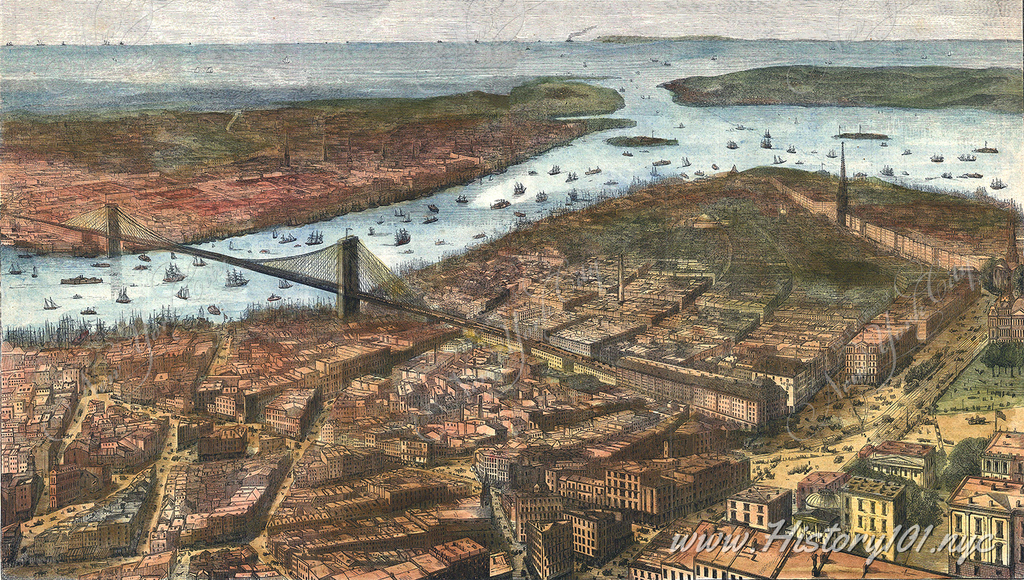
1883: German Map of Downtown and Brooklyn
This illustration from 1883 depicts a German map view of Lower Manhattan, the Brooklyn Bridge, and Brooklyn, offering a glimpse into the urban landscape of New York City during that era.
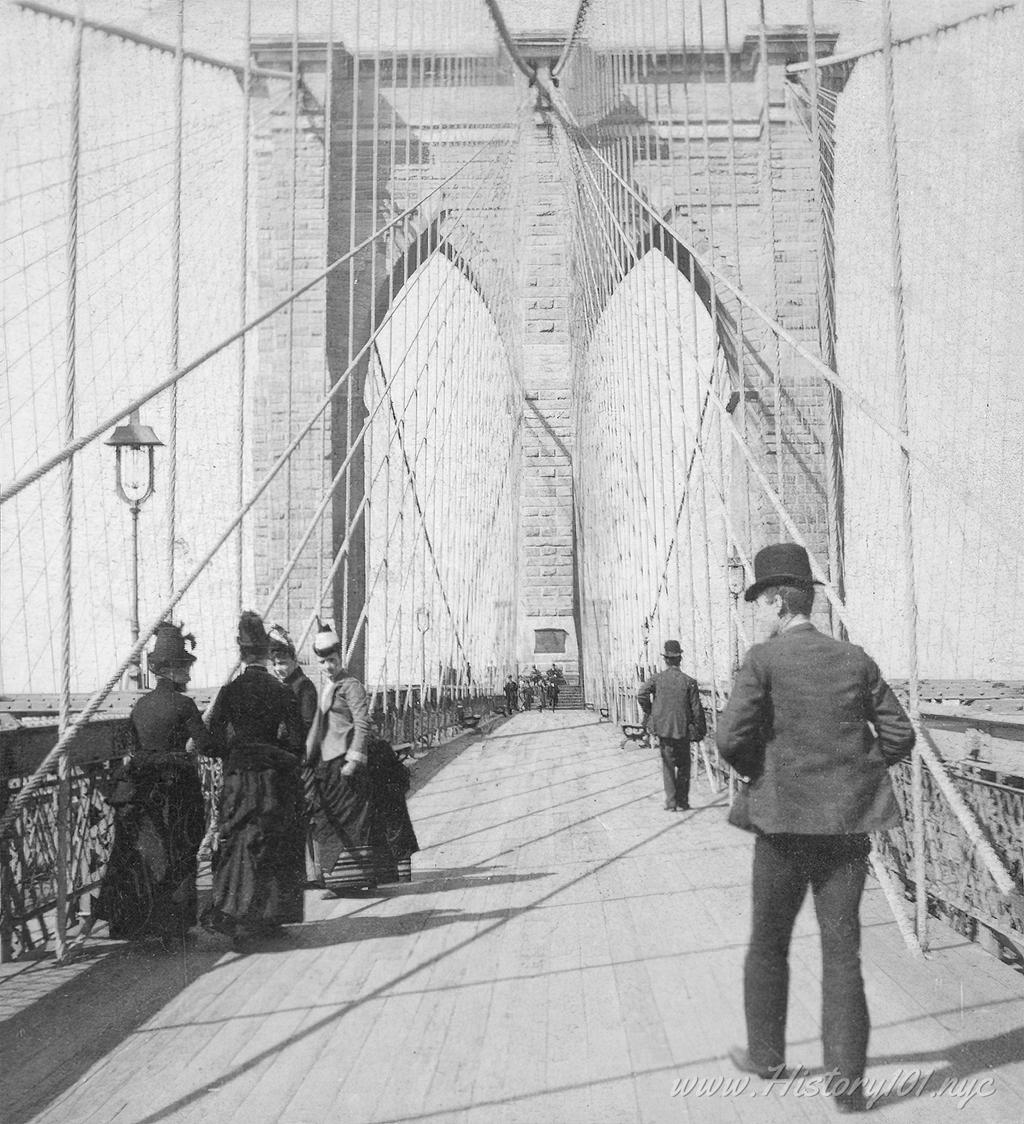
1883: Entrance to Brooklyn Bridge Promenade
An early photograph of the recently opened Brooklyn Bridge promenade - a much needed connection between Manhattan and Brooklyn.
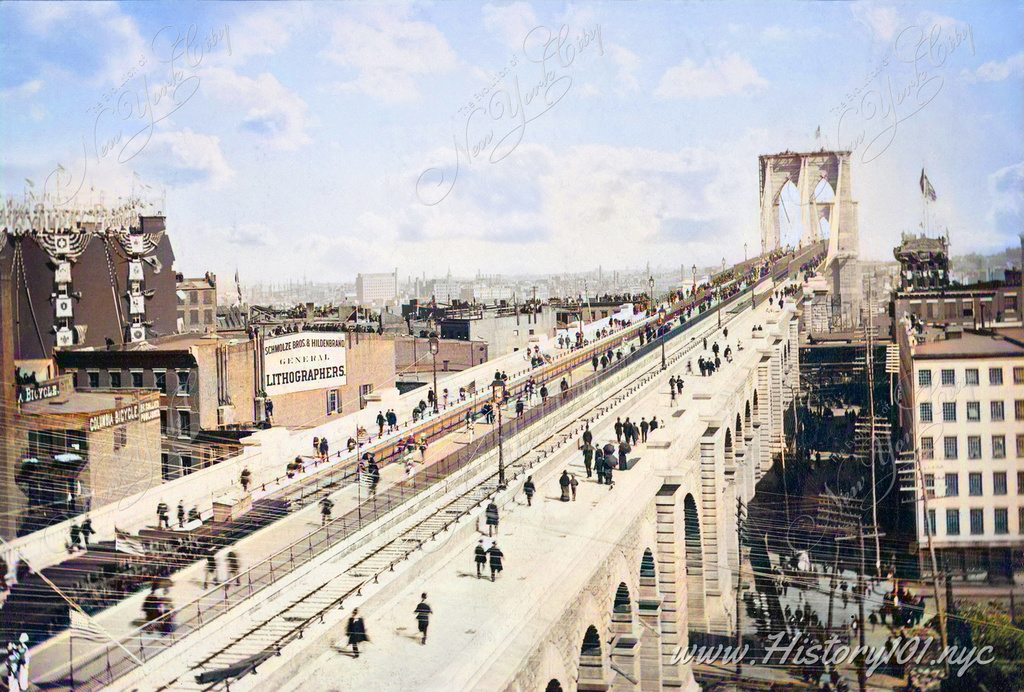
1883: Aerial View of the Brooklyn Bridge Overpass
Photo by Theodore Gubelman presents a view of the Brooklyn Bridge overpass, teeming with a multitude of pedestrians against the backdrop of Brooklyn in the distance.
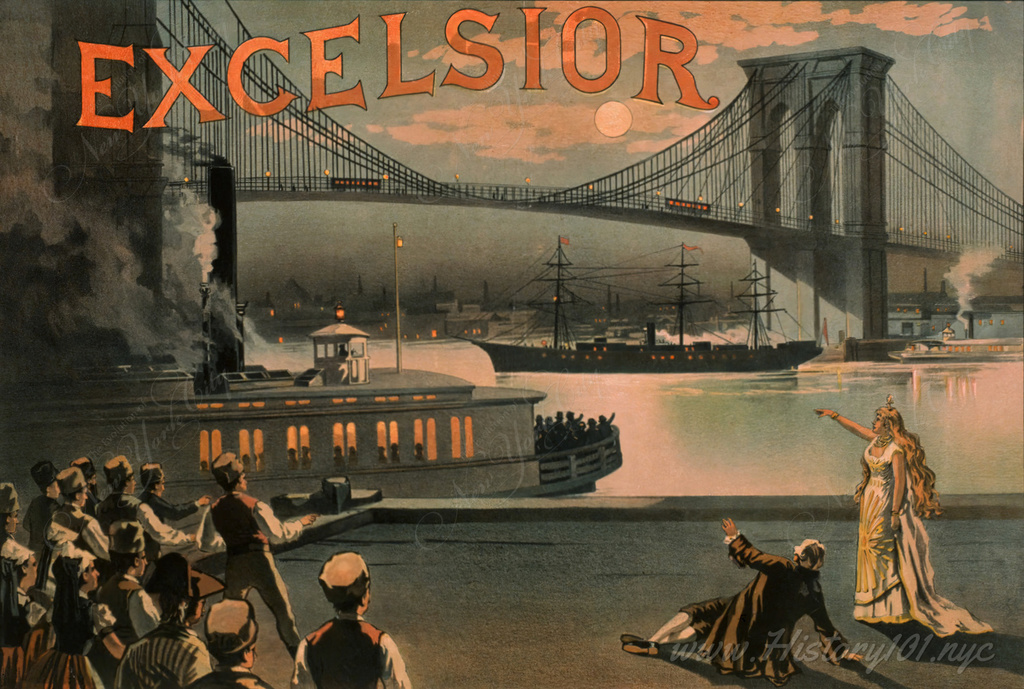
1883: Excelsior Brooklyn Bridge Poster
This illustration depicts the iconic Brooklyn Bridge in the late 19th century, standing majestically against the night sky.
Timeline of New York City: 1880-1889
1880: New York City experienced significant population growth during the late 19th century, with a population of approximately 1,206,299. The city's composition in 1880 included only Manhattan, as Brooklyn, Queens, The Bronx, and Staten Island were not yet part of the consolidated metropolis. These areas were independent, either as separate cities or parts of different counties, reflecting a more fragmented urban landscape. The consolidation of these boroughs into one city would later transform New York City into the expansive metropolis known today.
This era was characterized by a substantial influx of European immigrants, who brought diverse cultures, languages, and traditions to the city. This wave of immigration significantly enriched New York City's social and cultural fabric, shaping its identity as a melting pot. The city's demographic landscape was not just a numerical count, but a reflection of the diverse and vibrant community forming within its borders. The cultural diversity established during this period laid the foundation for the city's evolution into a modern metropolis, influencing its social, economic, and cultural dynamics.
1880: The American Society of Mechanical Engineers (ASME) was founded in New York City, marking a significant milestone in the field of engineering. This professional organization, established to advance the art and science of mechanical engineering, played a pivotal role in setting industry standards and promoting technical knowledge. The founding event took place on February 16, when a group of engineers and industry leaders gathered to formalize the creation of ASME. The society quickly became an essential platform for engineers to share innovations and best practices, fostering collaboration and growth within the profession.
ASME's establishment in New York City greatly benefited the city's development and industrial landscape. As a central hub for innovation and technology, the presence of ASME contributed to the city's reputation as a leader in engineering and industrial advancements. The organization's efforts to standardize engineering practices and provide professional development opportunities supported various industries, including manufacturing, transportation, and infrastructure. This foundation of engineering excellence helped propel New York City's growth, making it a key player in the nation's industrial progress and solidifying its statu
1880: New York City made a significant advancement in urban lighting technology by beginning its transition from gas to electric street lighting. The city introduced electric arc lamps on Broadway, providing a more efficient and brighter illumination compared to traditional gas lamps. These lamps, which produced light through an arc between carbon electrodes, were installed in December along the stretch of Broadway between 14th and 26th Streets. This marked one of the earliest implementations of electric street lighting in a major city, showcasing New York's commitment to adopting new technologies.
The introduction of electric arc lamps had a profound impact on New York City's urban landscape and overall development. The enhanced nighttime visibility and safety provided by these lamps improved the city's aesthetics and facilitated extended commercial and social activities after dark. This transition from gas to electric lighting was a crucial step toward modernization, laying the groundwork for further technological advancements in the city. It also played a significant role in the cultural and economic growth of New York City, helping to establish it as a leading metropolis and a symbol of progress and innovation.
1880: On October 2, Jesse B. Anthony, Grand Master of Masons in New York, presided over a grand ceremony to lay the cornerstone of Cleopatra's Needle in Central Park, New York City. This significant event was celebrated with a parade featuring over 9,000 marching up Fifth Avenue from 14th Street to 82nd Street, drawing an estimated 50,000 spectators. The obelisk, a 3,400-year-old artifact made of red granite, originally stood in the Egyptian city of Heliopolis and was erected by Pharaoh Thutmose III around 1475 BC. The Romans later moved it to Alexandria, placing it in the Caesareum, a temple built by Cleopatra. It was skillfully erected in its current location by a structure designed by Henry Honeychurch Gorringe, with the official ceremony taking place on January 22, 1881.
The placement of Cleopatra's Needle within Central Park was meticulously chosen in 1879 by Gorringe, William Henry Hurlbert, and Frederic Edwin Church. Selected for its isolated and elevated site, the location allowed for the foundation to be securely anchored in bedrock. Secured for New York in 1877 by Elbert E. Farman and installed with substantial funding from William Henry Vanderbilt, this ancient monument, inscribed by Ramesses II to commemorate his military victories, has faced considerable weathering in New York City's harsh conditions. This deterioration prompted Dr. Zahi Hawass to call for enhanced conservation efforts in 2010, highlighting the urgent need to preserve this invaluable link to ancient history, bridging cultures and epochs across thousands of years.
1880: Founded by Dr. Felix Adler as the Workingman's School, the Ethical Culture Fieldston School expanded to include elementary grades, catering to a wider student demographic. This expansion reinforced its commitment to progressive education for diverse backgrounds. By 1890, it gained a strong academic reputation, leading to the introduction of tuition fees due to increased demand and prestige.
In 1904, the school relocated to 33 Central Park West, Manhattan, enhancing its facilities for a growing student body. Further growth led to the high school division's move in 1928 to a spacious 18-acre campus in Riverdale, The Bronx. This development underscored the school's dedication to quality education across various educational stages.
1881: The New York State Senate moved into the new Senate Chamber of the Capitol building on March 10. This event marked a significant milestone in the construction and utilization of the new Capitol, which had been under development since 1867. Over the following eight years, various other rooms and facilities within the Capitol were gradually occupied, completing the transition into this grand and architecturally significant building. The Capitol's completion provided a modern and efficient space for the state's legislative activities, symbolizing the growth and modernization of New York's government.
This transition to the new Capitol was pivotal in enhancing the state's administrative capabilities, indirectly benefiting New York City. As the largest city in the state, New York City's governance and economic interests were closely tied to the efficiency of state legislation. The Capitol's new facilities enabled smoother legislative processes, contributing to more effective policymaking. This development played a crucial role in shaping the urban and political landscape of New York City, reflecting the city's interconnectedness with the broader governance of the state. The Capitol's completion highlighted the progress and ambition of New York during the late 19th century, reinforcing its status as a leader in both governance and architecture.
1881: Barnum & Bailey Circus, known as "The Greatest Show on Earth," made its debut at Madison Square Garden in New York City on March 18. This debut followed the merger of two prominent circus groups led by P.T. Barnum and James A. Bailey, combining their resources and talents. The event was a significant moment in the history of American entertainment, as the newly merged circus offered an unprecedented spectacle, featuring a wide array of acts and attractions that captivated audiences.
The arrival of Barnum & Bailey Circus in New York City marked a pivotal moment in the city's cultural development. Madison Square Garden, already a prominent venue, became a key location for major entertainment events, enhancing New York's reputation as a leading cultural hub. The circus's success at this venue highlighted the city's capacity to host large-scale performances and attract diverse audiences. This event not only enriched New York City's entertainment scene but also played a crucial role in shaping the city's identity as a center for arts and culture, influencing its trajectory as a global cultural capital.
1881: The United States National Lawn Tennis Association (USNLTA) was established on May 21, in New York City. This organization, which later became the United States Tennis Association (USTA), was created to standardize the rules of lawn tennis and organize competitions across the United States. Its formation was a pivotal moment in American sports history, laying the foundation for the growth and formalization of tennis as a competitive sport in the country.
The establishment of the USNLTA in New York City significantly benefited the city's cultural and athletic landscape. As the birthplace of the organization, New York City became a central hub for tennis in the United States, hosting major tournaments and fostering the sport's development. This contributed to the city's reputation as a premier destination for sports and cultural events. The presence of the USNLTA in New York City also helped elevate the city's status in the global tennis community, showcasing its role in promoting and supporting the sport.
1881: The New York City Department of Sanitation, initially known as the Department of Street Cleaning, was established to address the city's growing waste management challenges. Prior to the creation of this department, New York City struggled with an unsystematic approach to sanitation, which was inadequate for the city's expanding population and urbanization. The establishment of the department marked a significant step towards improving public health and cleanliness in the city. The official formation of the department took place on December 20, setting the foundation for a more organized and effective waste management system.
This new department played a crucial role in transforming New York City into a cleaner and healthier metropolis. Its inception introduced structured waste management practices that significantly improved the living conditions for residents. The New York City Department of Sanitation became a pioneer in the evolution of urban sanitation, influencing similar efforts in other cities around the world. The department's work was instrumental in addressing public health concerns and demonstrated the city's commitment to becoming a modern, health-focused urban center. This initiative not only improved the quality of life in New York City but also set a precedent for future advancements in urban sanitation and public health practices globally.
1881: William Russell Grace's election as New York City's first Catholic mayor, an Irish immigrant, marked a pivotal change in its cultural and political realms, previously dominated by Protestantism. His victory, a crucial milestone, underscored the growing acceptance of the city's diverse immigrant populace, particularly Irish Catholics. This period also saw the ascent of Tammany Hall's influence in city politics, denoting significant shifts in the political landscape.
Grace’s mayoral term was characterized by efforts to fight corruption and improve municipal service efficiency, mirroring a city-wide move towards professionalized and ethical governance. His administration, significant for its historical precedence, also symbolized the rising political clout of immigrants in U.S. urban centers, reflective of the broader social and political metamorphosis in late 19th-century New York City, aligning with national trends in immigration and socio-political evolution.
1882: The late 19th century was a transformative period for New York City, driven by the economic activities of influential industrialists. John D. Rockefeller established the Standard Oil Trust in the early 1880s, significantly consolidating multiple oil companies under one umbrella, which revolutionized business organization. Similarly, Andrew Carnegie and Henry Clay Frick played pivotal roles in advancing the steel industry, while the Morgans became prominent in banking. Cornelius Vanderbilt's dominance in transportation further solidified the city's economic stature. This confluence of industrial and financial powerhouses contributed to New York City's emergence as a leading industrial and financial hub.
The consolidation of industries during this time prompted the rise of industry-specific trusts, influencing the creation of U.S. antitrust legislation. Notably, the Sherman Antitrust Act was enacted in 1890, aiming to curb the monopolistic practices that had become prevalent. The influence of these magnates and their ventures had a profound impact on New York City's development, positioning it as a global commercial powerhouse. This era's events were instrumental in shaping the broader landscape of American business and economic history.
1882: British runner James Saunders achieved a new 24-hour amateur record by running 120 miles and 275 yards (193.3 km) at the American Institute Ring in New York City. This remarkable feat, accomplished with a 100-mile mark of 17 hours, 36 minutes, and 14 seconds, included an unusual $100 prize for an amateur event. The record-setting performance demonstrated Saunders' exceptional endurance and highlighted the growing popularity of long-distance running.
In February, Saunders' achievement significantly impacted New York City's reputation as a premier venue for athletic competitions. By hosting such events, the city showcased its capacity to support and promote various sports, attracting international talent and audiences. The race at the American Institute Ring exemplified the city's commitment to fostering a vibrant sporting culture, cementing its status as a key player in the global sports arena. Saunders' record not only elevated the profile of amateur athletics but also contributed to New York City's rich history as a hub for groundbreaking athletic accomplishments.
1882: The origin of National Waffle Day traces back to Sweden, where it is celebrated as "Våffeldagen" on March 25 each year. This day marks the beginning of spring in Sweden and is traditionally celebrated by indulging in waffles topped with jam or whipped cream. The holiday has gained popularity in various countries, where it serves as an opportunity to enjoy this beloved breakfast treat. National Waffle Day's timing coincides with the Feast of the Annunciation, also known as "Our Lady's Day," further emphasizing the day's significance in Swedish culture.
While the exact date of the first official U.S. pancake-making demonstration is not universally verified, there is a charming anecdote that suggests March 25, 1882, as a potential date for the event at a New York City department store. Pancake Day, also celebrated around this time in various countries, is especially popular in the United Kingdom, Ireland, Australia, New Zealand, and Canada. Known as Shrove Tuesday in some regions, Pancake Day is celebrated with enthusiasm, as people enjoy pancakes with various toppings such as syrup, lemon, and sugar.
1882: The Chinese Exclusion Act, a landmark federal law, was enacted on May 6. This legislation imposed a 10-year ban on Chinese labor immigration, making it the first U.S. law to restrict immigration based solely on ethnicity. The act was signed by President Chester A. Arthur and reflected the growing anti-Chinese sentiment in the United States during that era. The law aimed to curb the influx of Chinese laborers, who were perceived as economic competitors and cultural outsiders by many Americans.
The impact of the Chinese Exclusion Act was notably felt in New York City, particularly within its Chinatown community. As a hub for Chinese immigrants, the city experienced significant demographic shifts due to the act's restrictions. The law limited the growth of the Chinese population and led to increased scrutiny and discrimination against Chinese residents. New York City's response to the act and the resilience of its Chinese community highlighted the complexities of immigration, ethnicity, and labor during this period.
1882: Doris Ulmann, an influential American photographer, was born in New York City. Best known for her portraits of the people of Appalachia, Ulmann's work captured the essence of rural American life and its diverse cultures. Her photography focused on individuals from various backgrounds, often highlighting the lives of marginalized communities. Ulmann's career spanned several decades, during which she produced an extensive body of work that documented the unique character and traditions of her subjects. She continued her work until her death in 1934.
The birth of Doris Ulmann in New York City on May 29, marked the beginning of a significant career in American photography. Her New York origins influenced her artistic sensibilities, as the city was a hub of cultural and artistic diversity. Ulmann's work, while centered on rural America, provided a contrast to the urban environment of New York City, enriching the city's cultural tapestry. Her contributions to photography helped document the varied American experience, adding depth to the city's legacy as a center for artistic expression and innovation.
1882: The electric iron was patented by Henry W. Seely, an inventor from New York, marking a significant advancement in household appliances. This early model, patented on June 6, weighed nearly 15 pounds and took a long time to heat up. Despite its impracticality compared to modern standards, Seely's invention was a groundbreaking innovation in the field of domestic technology. The electric iron provided an alternative to traditional methods of ironing, such as using irons heated on stoves, which were less consistent and more labor-intensive.
The patenting of the electric iron in 1882 was an important milestone in New York City's history, reflecting the city's role as a hub of technological innovation during the late 19th century. This invention contributed to the electrification of household devices, a trend that significantly transformed everyday life. Seely's work exemplified the inventive spirit that characterized New York City at the time, highlighting its position as a center for creativity and industrial progress. The introduction of the electric iron laid the groundwork for future improvements in household appliances, ultimately making domestic chores more efficient and less labor-intensive for New Yorkers and beyond.
1882: The Pearl Street Station, constructed by the Edison Illuminating Company, was inaugurated on September 4, at 255–257 Pearl Street in Manhattan. It was the first commercial central power plant in the United States. The station initially operated with six 100 kW dynamos, providing electricity at 110V DC to 400 lamps for 82 customers. By 1884, it had expanded to serve 508 customers with a total of 10,164 lamps. This facility marked a significant advancement in electric power distribution, representing a major leap in the availability and use of electricity.
Beyond its role as a power plant, Pearl Street Station was the world's first cogeneration plant, efficiently utilizing steam engines for both electricity generation and thermal byproducts for local heating. In 1882, Thomas Edison introduced electrified streets and buildings in Manhattan, starting with 59 customers at Pearl Street, offering free electricity to familiarize the city with this new power source. This initiative played a crucial role in encouraging the widespread adoption of electricity in New York City, setting the stage for its eventual integration into daily life over the following decade.
1882: The first Labor Day parade in the United States took place in New York City. The event, organized by the Central Labor Union, saw approximately 10,000 workers marching through the streets. The parade began at City Hall and proceeded to Union Square, where participants gathered for speeches and festivities celebrating the contributions of the American workforce. This demonstration was a landmark event in the labor movement, emphasizing the need for better working conditions and fair treatment of workers.
On September 5, the inaugural Labor Day parade in New York City marked a significant moment in the city's history and the broader American labor movement. The event not only highlighted the solidarity and organization among workers but also set a precedent for future celebrations of Labor Day, which later became a national holiday. This parade underscored New York City's role as a central hub for labor activism and advocacy, reflecting the city's commitment to social justice and workers' rights. By hosting this historic event, New York City contributed to the national discourse on labor issues and helped pave the way for future advancements in labor legislation and workers' protections.
1882: John Lowry, an American builder known for his significant contributions to New York City's architectural landscape, was born on November 13, in Mount Vernon, New York. Although widely recognized for his work on various notable buildings, Lowry is often associated with the development of Radio City Music Hall, a cornerstone of the Rockefeller Center complex. His career spanned several decades, during which he played a vital role in constructing some of the city's most iconic structures. Lowry's contributions to New York City's skyline exemplify the era's architectural innovation and the city's growth as a cultural hub.
The construction of Radio City Music Hall, completed in 1932, marked a significant achievement in New York City's history. As a prominent entertainment venue, it has hosted numerous performances, events, and shows, attracting visitors from around the world. The venue's opening contributed to New York City's reputation as a global center for arts and culture. The architectural and cultural impact of Radio City Music Hall, along with Lowry's involvement in its construction, reflects the broader narrative of New York City's development during the early 20th century. The venue remains a testament to the city's rich cultural heritage and its role as a leading destination for entertainment and innovation.
1882: Fiorello H. La Guardia, an influential American politician and long-serving Mayor of New York City, was born in New York City. La Guardia's tenure as mayor began in 1934 and lasted until 1945. He was known for his leadership during the Great Depression and World War II, focusing on progressive policies and reform. La Guardia's administration was characterized by efforts to combat corruption, improve public services, and implement significant infrastructure projects, including the development of the city's airports and public housing initiatives.
Born on December 11, Fiorello La Guardia played a pivotal role in shaping New York City's history. His leadership helped navigate the city through one of its most challenging periods, fostering resilience and modernization. The establishment of LaGuardia Airport and numerous public works projects under his administration contributed significantly to the city's growth and development. La Guardia's legacy includes his dedication to good governance and public welfare, which left an indelible mark on New York City, enhancing its status as a leading global metropolis. His contributions continue to influence the city's civic and political landscape, reflecting the enduring impact of his mayoral tenure.
1883: The Brooklyn Bridge opened on May 24, connecting the boroughs of Manhattan and Brooklyn. At its inauguration, it was the world's longest suspension bridge, with a span of 1,595.5 feet, surpassing previous bridges by 50%. The bridge was conceived by John A. Roebling, a pioneering engineer, and completed by his son, Washington Roebling, after John Roebling's death. The construction of the Brooklyn Bridge was a remarkable engineering achievement, setting new standards in bridge design and construction. Its completion marked a significant moment in New York City's history, showcasing the city's technological advancements and ambition.
The opening of the Brooklyn Bridge symbolized the unification of Manhattan and Brooklyn, significantly improving transportation and facilitating the movement of people and goods between the two boroughs. This infrastructure project was not only a practical solution to congestion on the ferry system but also a monumental symbol of the city's growth and interconnectedness. The bridge quickly became an iconic landmark, representing New York City's innovative spirit and urban evolution. Its unique architectural style and historical significance have made it a lasting emblem of the city's resilience and ingenuity, solidifying its status as one of the most recognizable structures in the world.
1883: A tragic incident occurred on the newly opened Brooklyn Bridge when a false rumor spread among pedestrians, causing panic and resulting in a deadly stampede. This unfortunate event, just days after the bridge's opening, led to the loss of twelve lives. The panic was triggered by a widespread belief that the bridge was collapsing, illustrating the dangers of misinformation in public spaces. The incident highlighted the vulnerabilities in managing large crowds and the critical importance of reliable information in preventing such disasters.
On May 30, the stampede on the Brooklyn Bridge underscored the need for better crowd control and effective communication systems in New York City. The tragedy emphasized the essential role of accurate reporting and the responsibilities of the media in preventing public hysteria. It served as a significant lesson in urban safety management, demonstrating how quickly a situation can escalate in the absence of proper information and control measures. This event remains a stark reminder of the complexities involved in maintaining public safety in rapidly evolving urban settings, particularly in iconic structures like the Brooklyn Bridge.
1883: The Metropolitan Opera Company was founded as a response to the exclusivity of the Academy of Music. The initiative was led by 22 prominent industrialists and financiers who met at Delmonico's restaurant in 1880. These influential families, including the Morgans, Roosevelts, and Vanderbilts, sought to create an opera venue that would cater to New York City's growing elite and provide a more inclusive cultural experience. The result was the establishment of a new opera house, located at 39th Street and Broadway, designed to rival and surpass the Academy of Music in luxury and grandeur.
The new Metropolitan Opera House opened with a performance of Charles Gounod's "Faust," marking a significant cultural and societal shift in New York City. The venue quickly became a symbol of the city's evolving social dynamics, showcasing the rising influence of the new wealthy industrial elite. The Met's opulence and accessibility attracted a broader audience, leading to the eventual decline of the Academy of Music, which ceased operations three years later. The founding of the Metropolitan Opera Company reflected the changing landscape of New York's cultural and social scene, highlighting the emergence of new power structures and the city's growing importance as a center for the arts.
1883: The original Metropolitan Opera House in New York City had its grand opening on October 22. This inaugural event featured a performance of Charles Gounod's opera "Faust," marking the beginning of a significant cultural institution in the city's history. The opera house, located at 1411 Broadway, was established by a group of wealthy New Yorkers who sought to create a premier venue for opera in the city. The opening night was a major social event, attended by many of New York's elite, and it set the stage for the Metropolitan Opera to become one of the most prestigious opera companies in the world.
The grand opening of the Metropolitan Opera House on October 22, was a pivotal moment in New York City's cultural development. The establishment of the Met brought world-class opera performances to the city, significantly enhancing its artistic landscape. It played a crucial role in elevating New York City's status as a global center for the performing arts, attracting renowned artists and audiences from around the world. The Metropolitan Opera House became a symbol of the city's dedication to cultural excellence, fostering a rich tradition of opera and music that continues to this day. The impact of the Met's opening extended beyond the arts, influencing the city's social and cultural life and contributing to its reputation as a leading cultural metropolis.
1883: The "Day of Two Noons" occurred on November 18, when American and Canadian railroads implemented standardized time zones across North America. This change was necessary to eliminate the confusion caused by each locality setting its time based on the position of the sun. On that day, many railroad stations reset their clocks at noon to match the newly established time zones, resulting in some locations experiencing two noons—one at local solar time and another according to the new standard time. This initiative was spearheaded by the railroads to improve scheduling efficiency and reduce the complexity of timekeeping across different regions.
For New York City, a major center of commerce, finance, and transportation, the adoption of standardized time zones was particularly impactful. The shift streamlined operations in various sectors, including train scheduling, banking, and communications, ensuring better coordination with other parts of the country. The transition to standard time highlighted New York City's adaptability and its role in a modern, interconnected world. This change marked a significant moment in the city's history, as it embraced the new system that would enhance its functionality and connectivity on a national and global scale.
1883: Life magazine began its journey in New York City as a humor and general interest publication, distinct from the later famous photojournalistic magazine. Launched in January, its debut marked an addition to the city's thriving publishing sector, blending satire, humor, and eventually, social and political discourse.
The inception of Life magazine significantly shaped New York City's cultural and media landscape. It introduced a unique facet to the city's artistic and journalistic realms, setting a precedent for the style and content of subsequent publications. Its presence underscored New York City's growing influence as a hub of media and culture, playing a key role in shaping public opinion.
1883: In the early 1880s, a significant shift in U.S. immigration patterns occurred with the arrival of many Jewish immigrants from Eastern Europe. This change was largely due to increased persecution following the assassination of Czar Alexander II in 1881. Under Czar Alexander III, Jewish populations faced violent pogroms and harsh policies, prompting many to seek refuge in the United States. By 1883, New York City, which already had a population of around 80,000, primarily of German origin, began to experience a considerable influx of Eastern European Jewish immigrants.
This influx had a profound impact on New York City's cultural and social landscape. Many settled in neighborhoods such as the Lower East Side, bringing with them a diverse range of cultural traditions, languages, and practices. This period marked a transformative era in the city's history, as it evolved into a multicultural metropolis. The arrival of these immigrants not only diversified the city's demographic profile but also significantly enriched its economic and cultural life. Their contributions became an integral part of New York City's identity, helping to establish it as a welcoming center for immigrants and a hub of diverse cultural exchange.
1884: The cornerstone for the Statue of Liberty's pedestal was laid on August 5, on Bedloe's Island, now known as Liberty Island, in New York Harbor. This event marked a significant milestone in the construction of one of the most iconic symbols of freedom and democracy. The statue, a gift from the people of France, was designed by sculptor Frédéric Auguste Bartholdi and constructed with the engineering expertise of Gustave Eiffel. The completion of the pedestal was crucial for the installation of the statue, which was shipped to the United States in 350 individual pieces.
The dedication of the Statue of Liberty took place on October 28, 1886, officiated by President Grover Cleveland. This momentous event not only celebrated the completion of a monumental work of art but also solidified New York City's reputation as a welcoming gateway for immigrants. The statue, towering over the entrance to New York Harbor, quickly became a symbol of hope and a landmark of American ideals. Its presence continues to influence the cultural and historical narrative of New York City, embodying the city's spirit and diversity.
1884: Maxwell Perkins, the influential American editor, and publisher, was born on September 20, in New York City. He played a pivotal role in shaping American literature by discovering and nurturing the talents of Ernest Hemingway, F. Scott Fitzgerald, and Thomas Wolfe. Perkins worked at Charles Scribner's Sons, where he became known for his keen editorial insight and support for emerging writers. His contributions to literature significantly impacted the publishing industry, helping to establish New York City as a literary hub.
Perkins' dedication to his authors and his innovative approach to editing helped bring many literary classics to life. His efforts not only shaped the careers of some of the most prominent American authors but also enriched New York City's cultural landscape. The city's literary history was profoundly influenced by Perkins' work, as it became a center for literary talent and intellectual exchange. His legacy continues to be celebrated, reflecting the enduring importance of New York City in the world of literature.
1884: Eleanor Roosevelt, a prominent American diplomat, activist, and First Lady of the United States from 1933 to 1945, was born on October 11, in New York City. She became a leading figure in advocating for social justice and human rights, significantly influencing American and global politics. Eleanor played a key role in the formation of the United Nations and was a pivotal member of the UN Commission on Human Rights. Her efforts culminated in the drafting of the Universal Declaration of Human Rights, a cornerstone document in international human rights law.
Born into a distinguished New York family, Eleanor Roosevelt's early experiences in the city shaped her deep empathy and commitment to public service. As First Lady, she used her influence to champion civil rights and women's rights, bringing attention to issues often overlooked by mainstream politics. Her work not only elevated the social conscience of the nation but also solidified New York City's reputation as a hub for progressive thought and activism. Eleanor's legacy endures as a testament to the city's role in fostering leaders dedicated to social change and human dignity.
1884: Sporting Life announced on October 22, that the National League and American Association pennant winners would compete in a groundbreaking three-game series at the Polo Grounds in New York City. This significant event marked the first official championship series in baseball history, pitting the Providence Grays of the National League against the New York Metropolitans of the American Association. The games were scheduled for October 23-25, setting a precedent for future postseason competitions.
The series, held at the Polo Grounds, highlighted New York City's growing role as a major sports hub in the United States. The Providence Grays emerged victorious, becoming the first official baseball champions. This event not only established the concept of a national baseball championship but also contributed to New York City's rich sports culture and history. The city's role in hosting this pioneering series underscored its importance in the early development of professional baseball and solidified its reputation as a key venue for major athletic events.
1884: The Dakota, a landmark apartment building in New York City, was designed by architect Henry Janeway Hardenbergh and officially opened. Located at the corner of 72nd Street and Central Park West, this iconic structure is renowned for its unique blend of architectural styles, including German Renaissance, Chateauesque, and Gothic Revival. The Dakota was one of the first luxury apartment buildings in Manhattan, offering upscale amenities and attracting wealthy residents. Its prime location and distinctive design contributed significantly to the appeal and transformation of the Upper West Side.
The building's grand opening took place on October 27, marking a significant moment in New York City's architectural history. The Dakota quickly became a desirable address, known for its opulent interiors and luxurious living spaces. The building has housed numerous notable residents, including John Lennon, who lived there from 1973 until his assassination at the building's entrance on December 8, 1980. The Dakota's historical and cultural significance is further commemorated by the nearby Strawberry Fields Memorial, dedicated to Lennon's memory. The Dakota remains an enduring symbol of New York City's rich architectural and cultural heritage.
1884: The Hotel Chelsea, an iconic landmark in Manhattan's Chelsea neighborhood, opened its doors, marking a significant moment in New York City's architectural history. The building, known for its Victorian Gothic style, features a distinctive façade and intricate design, showcasing the urban development and architectural trends of the late 19th century. As one of the city's most prominent examples of the era's aesthetic, the Hotel Chelsea has contributed to the architectural diversity and rich heritage of New York City.
The hotel has long been a cultural hub, fostering a vibrant artistic community. It has been a residence and gathering place for numerous artists, musicians, and writers, including notable figures like Bob Dylan, Arthur Miller, and Patti Smith. The hotel's legacy as a sanctuary for creativity and expression has made it a symbol of New York City's cultural history. Today, the Hotel Chelsea continues to represent the city's ongoing commitment to nurturing artistic talent and fostering a creative atmosphere.
1884: The New York Cancer Hospital marked a significant milestone in New York City's medical history as one of the first U.S. institutions dedicated to cancer care and research. It set a new standard in oncology treatment. This pioneering facility later evolved into the renowned Memorial Sloan Kettering Cancer Center, maintaining its legacy of medical innovation and specialized patient care.
Instrumental in advancing New York City's public health sector, the hospital provided focused care for cancer patients, filling a critical gap in specialized medical services. Its establishment underscored the city's commitment to confronting complex health issues and leading in medical research, significantly contributing to the evolution of the city's healthcare landscape.
1884: The Brearley School has been pivotal in advancing women's education in New York City. Founded as a private all-girls institution, it broke new ground by providing quality education to girls at a time when such opportunities were scarce, significantly furthering gender equality in educational access.
Renowned for its rigorous academic standards, the Brearley School has played a key role in enhancing New York City's educational landscape. Its focus on both academic and holistic development set new benchmarks for private education, contributing to the city's reputation for educational excellence.
1884: The Grolier Club stands as the oldest and largest society for book lovers and graphic arts enthusiasts in America, significantly contributing to New York City's cultural and educational landscape through the promotion of book arts. The club's activities, including numerous exhibitions, lectures, and its extensive book collection, have enriched New York's cultural heritage.
The Grolier Club has also played a crucial role in preserving rare books and literary artifacts, contributing to the safeguarding of literary history. Its impact on book collecting and scholarship goes beyond the city, influencing international standards and practices in these fields. The establishment of the Grolier Club marked a pivotal moment in New York City's history, underlining its status as a center for literary and educational excellence and its dedication to cultural and scholarly endeavors.
1885: The Statue of Liberty, a symbol of freedom and democracy, arrived in New York Harbor on June 17. This monumental statue, a gift from the people of France, was designed by the renowned sculptor Frédéric Auguste Bartholdi. The statue was transported across the Atlantic Ocean on the French frigate Isère, disassembled into 350 pieces and packed in 214 crates. The project was a collaborative effort between France and the United States, commemorating the centennial of the American Declaration of Independence and celebrating the enduring friendship between the two nations.
After its arrival, the statue's pieces were stored on Bedloe's Island, now known as Liberty Island, as work continued on the pedestal. Designed by American architect Richard Morris Hunt, the pedestal was completed in April 1886, allowing the reassembly of the statue to commence. This process took approximately four months, culminating in the statue's official dedication on October 28, 1886, by President Grover Cleveland. This dedication ceremony marked the completion of a remarkable international collaboration and the establishment of an enduring icon. The Statue of Liberty remains an emblematic landmark, representing New York City's role as a gateway to freedom and opportunity for millions of immigrants
1885: Ulysses S. Grant (April 27, 1822 – July 23, 1885), the 18th President of the United States, was interred in a temporary vault in Riverside Park, New York City. This vault was designed by Calvert Vaux and marked a significant moment for the city, as it honored a notable national figure. The temporary vault served as an interim memorial until a more permanent site could be established.
Grant's Tomb, the permanent memorial, was dedicated in 1897. Designed by John Duncan, its unveiling was marked by a grand ceremony with 60,000 marchers and a naval review on the Hudson River. Located in Riverside Park, the tomb stands as a historic and cultural landmark in New York City, celebrating President Grant's legacy and enhancing the city's architectural and cultural landscape.
1885: The New York State Legislature officially adopted the 1850s version of the New York State Coat of Arms as the permanent design and "legal form" of the State Seal. This version, known as "The Great Seal of New York," features a detailed depiction of a shield with the sun rising behind Mount Beacon over the Hudson River, representing hope and progress. The seal also includes symbols of Liberty and Justice, reflecting the state's foundational values of freedom and fairness. This adoption solidified the design as an enduring symbol of New York State's identity and governance.
The decision to formalize the seal's design in 1885 was a significant moment in New York's history, as it provided a consistent and official representation of the state's heritage and aspirations. The seal's imagery, including the world globe and soaring eagle, emphasizes New York's growing importance on both a national and global scale. This adoption not only reinforced the state's cultural identity but also played a role in the broader trend of establishing official state symbols during a period of modernization and development in New York City. The enduring use of this seal reflects New York's ongoing commitment to its values and its place in American history
1885: Governor Grover Cleveland appointed Isaac Perry to oversee the completion of the New York State Capitol in Albany. This appointment followed the dismissal of architects Leopold Eidlitz and Henry H. Richardson, who had been working on the building since the mid-1870s. Perry, originally serving as Capitol Commissioner, was tasked with expediting the project's progress amid escalating costs and delays. Under his supervision, significant portions of the Capitol were completed, including the renowned Great Western Staircase.
Following the death of Henry H. Richardson in 1886, Perry assumed full responsibility for implementing Richardson's designs and plans. The New York State Capitol, completed in 1899, became one of the most significant architectural achievements of its time, marked by its Romanesque Revival style. The building's completion was a pivotal moment in the state's history, symbolizing New York's commitment to its governmental and cultural institutions. The Capitol's construction, spanning over three decades, significantly contributed to Albany's development as a prominent political and cultural center.
1885: The Exchange Buffet opened in New York City, on September 4, marking a significant moment in the city's culinary history. This establishment, located in the financial district, was one of the earliest self-service restaurants in the United States. The Exchange Buffet was unique for its time, as it operated on an honor system where patrons would select their food from a counter and then report their purchases. This innovative model offered a fast and efficient dining option, particularly appealing to the busy professionals in the area (Boston University) (Fantastic Facts) (Wikipedia).
The introduction of the Exchange Buffet represented a shift in the dining culture of New York City, providing a new model for quick and affordable meals. Its success paved the way for the proliferation of cafeteria-style dining, influencing the development of similar establishments both within the city and across the country. This innovation contributed to New York City's reputation as a pioneer in diverse culinary offerings and laid the groundwork for future dining trends. The Exchange Buffet's legacy highlights the city's role in shaping modern dining experiences
1885: The Standard Oil Building, constructed in New York City, symbolized the era's economic and architectural advancements. Associated with the influential Standard Oil Company led by John D. Rockefeller and built in 1885, the building embodied the growing power of corporate America, particularly in the oil industry. It marked an important development, reflecting the late 19th-century economic dynamism.
The addition of the building to the city's skyline represented New York City's emerging role as a major center for business and finance, highlighting the rapid urban and architectural progression. As a significant structure, it emphasized the city's status as a hub for major industries and corporations, demonstrating its ability to host and represent key economic players.
1886: The Nightingale, the first nursing journal, was published on March 6, marking a significant milestone in the development of nursing as a scientific discipline. Under the influence of Florence Nightingale, this journal played a crucial role in transforming nursing into an independent and respected field of healthcare. It provided a dedicated platform for sharing nursing knowledge and practices, helping to elevate the profession during its formative years.
In October 1900, the American Journal of Nursing (AJN) began publication, becoming the first nursing journal owned and operated by nurses. AJN remains the oldest nursing journal still in circulation, highlighting its enduring impact on the profession. This achievement further underscored New York City's critical role in advancing nursing education and healthcare, solidifying its place as a leader in medical innovation.
1886: David Barnard Steinman, a pioneering American civil engineer, was born in New York City on June 11. Renowned for his expertise in bridge design, Steinman played a crucial role in shaping modern infrastructure in the United States. His innovative designs and engineering practices contributed to the construction of iconic bridges that have stood the test of time, solidifying his legacy as one of the most influential engineers of his era.
Among his notable achievements, Steinman was instrumental in the design and construction of the George Washington Bridge, which spans the Hudson River, and the Triborough Bridge, now known as the Robert F. Kennedy Bridge. These structures, completed later in the 20th century, significantly improved transportation in New York City, enhancing connectivity and supporting the city's growth as a major urban center. His work remains a testament to the enduring impact of engineering excellence in New York City.
1886: The Statue of Liberty, a gift from France symbolizing freedom and democracy, was designed by sculptor Frédéric Auguste Bartholdi and constructed between 1875 and 1884. After its completion, the statue was disassembled, shipped to New York City in 214 crates, and reassembled on Liberty Island over two years. Its construction and placement on a pedestal funded by public donations demonstrated New York City's ability to undertake monumental projects, reinforcing its cultural and historical significance.
On October 28, the Statue of Liberty was officially dedicated by U.S. President Grover Cleveland, an event that marked the first-ever ticker-tape parade in New York City. This historic dedication not only celebrated the statue as a symbol of liberty but also highlighted New York City's role as a welcoming gateway for millions of immigrants. The event solidified the city's identity as a beacon of hope and freedom, with the Statue of Liberty becoming an enduring symbol of these values.
1886: The Aguilar Free Library, established in New York City, played a significant role in enhancing the city's educational and cultural landscape during a period of rapid growth and a rising immigrant population. Founded by the Jewish community in memory of Grace Aguilar, the library provided essential educational resources, helping immigrants integrate into American society. By offering access to books and information, the library became an invaluable resource for those seeking to improve their lives through education.
As it evolved, the Aguilar Free Library became more than just a repository of books; it developed into a community hub and a symbol of New York City's dedication to public education and cultural enrichment. Its establishment in 1886 reflected the city's commitment to fostering diversity and intellectual development, playing a crucial role in the social evolution of New York during the late 19th century. The library's historical significance highlights New York City's status as a progressive metropolis focused on education and cultural advancement.
1886: The first national accountants' society in the United States, the American Association of Public Accountants (AAPA), was formed in New York City, marking a pivotal moment in the history of the accounting profession. This organization was established to regulate the practice of accounting, set professional standards, and promote ethical practices among accountants. The formation of the AAPA laid the groundwork for the future development of the accounting profession in the U.S.
On December 22, the AAPA was officially established in New York City, further reinforcing the city’s role as a central hub for finance and professional services. The creation of this society highlighted New York City's leadership in establishing professional standards and contributed to the city's growth as a major economic and commercial center during the late 19th century. The AAPA's founding played a crucial role in shaping the accounting profession, which continues to have a lasting impact on the city's financial industry.
1887: The Port of New York Longshoremen's Strike, initiated on January 27, was a pivotal event in New York City's labor history. Organized by longshoremen, responsible for managing cargo in one of the world's leading ports, it focused on demanding improved wages and working conditions. This reflected wider labor issues prevalent at the time.
This several-week-long strike significantly disrupted the port's activities and the city's trade, impacting the local economy. It was a key part of the late 19th-century labor movements across the United States, underscoring workers' growing awareness and solidarity. The strike notably spotlighted working-class conditions, laying the groundwork for future labor reforms.
1887: Teachers College emerged as a pioneering graduate school in education, affiliating with Columbia University in 1898. Founded in New York City, it was one of the nation's first institutions dedicated to education as a distinct discipline, marking a key advancement in educational development that impacted both the city and the country.
The institution's alliance with Columbia in 1898 elevated its stature, establishing it as a prime center for educational research and training. Influencing teaching methods and theories, Teachers College shaped the educational framework significantly, contributing crucially to educational practices and policies at a critical juncture in American educational history.
1887: Horace Mann School, named after Horace Mann, the "Father of American Public Education," began as part of Teachers College, Columbia University. Founded in New York City, it initially served as a laboratory school, exemplifying progressive educational practices and theories.
Influential in New York City's educational scene, Horace Mann School set a standard for progressive education. Its partnership with Teachers College and innovative methods significantly impacted educational practices locally and nationally, symbolizing New York City's contribution to educational reform and innovation.
1887: Peter Luger Steak House, established in Brooklyn, has become a quintessential part of New York City's rich dining culture. Known for its exceptional quality steaks and distinctive atmosphere, the steakhouse quickly rose to prominence and has maintained its status as a top-tier dining destination. As one of the oldest steakhouses in the city, Peter Luger's has been instrumental in defining the classic American steakhouse experience, consistently attracting both locals and visitors with its renowned menu offerings.
The establishment of Peter Luger Steak House marked the beginning of a longstanding tradition in New York City's culinary scene. Its influence extends beyond mere culinary excellence; it is a cultural icon that enhances New York City's reputation as a premier destination for exceptional dining experiences. The steakhouse's appeal contributes significantly to the city’s diverse and vibrant character, making it a must-visit location for those seeking the epitome of classic steakhouse cuisine in a city celebrated for its dynamic food culture.
1887: The Small Parks Act, passed on May 13, by the New York State Legislature, revolutionized urban planning within New York City by enabling the creation of parks in densely populated areas. This legislative move addressed the urgent need for green spaces in crowded neighborhoods, setting the stage for significant changes in the city's landscape. As urban density increased, the provision made by the Act allowed for the development of vital recreational spaces, improving the quality of urban life and providing residents with much-needed areas for leisure and social interaction.
This legislation began to visibly shape New York City's parkscape in the 1890s, leading to the establishment of several key parks by 1902. Notable among these were Mulberry Bend Park (later renamed Columbus Park), Hudson Park (later renamed James J. Walker Park), and De Witt Clinton Park. Situated within crowded neighborhoods, these parks became essential centers for public recreation and community engagement, significantly enhancing the urban environment and contributing to the well-being of countless residents. The establishment of these parks marked a pivotal moment in the city's commitment to improving urban life through thoughtful planning and development.
1888: "The Great Blizzard of 1888" or "Great White Hurricane" struck from March 12 to 13, devastating the northeastern U.S., including New York City, with about 21 inches (53 cm) of snow and winds that formed 20-foot drifts. This catastrophic weather event drastically dropped temperatures, caused over 400 deaths, and paralyzed the Eastern seaboard from Maryland to Maine.
In New York City, the blizzard's impact was profound, blocking roads and halting transportation, including streetcars and railways. This catastrophe exposed the city's vulnerability to severe weather, prompting significant urban planning and infrastructure reforms. Key post-blizzard changes included enhanced snow removal techniques and underground telegraph and telephone lines, boosting the city's preparedness for future winter storms.
1888: Following the 1883 New Park Commission's recommendation, New York City acquired 3,495 acres of parkland in the Bronx, including St. Mary's, Claremont, Crotona, Bronx, Van Cortlandt, and Pelham Bay parks, alongside Bronx, Pelham, Crotona, and Mosholu Parkways. This expansion, completed in 1888, marked a significant enhancement in the city's public green spaces.
This acquisition, costing $9.5 million, was a strategic investment that crucially developed the city's public parks system. It not only transformed the Bronx's urban landscape but also emphasized the importance of public parks in urban planning and improving residents' quality of life. This move was integral to New York City's efforts in upgrading urban living conditions and providing accessible recreational areas.
1888: The Washington Bridge, spanning the Harlem River between Manhattan and the Bronx, stands as a significant engineering achievement from the late 19th century. Its completion heralded a new era in urban connectivity, facilitating easier access between these two bustling boroughs. The bridge's architectural prowess and functionality contributed substantially to the development of the area, enhancing the flow of commerce and daily commuting for residents.
Completed in 1888, the Washington Bridge became an essential transportation link that triggered considerable urban growth, particularly in the Bronx. This crucial infrastructure project not only improved transit across the Harlem River but also played a pivotal role in shaping New York City's urban landscape. It marked a transformative moment in the city's history, fostering expansion and development that echoed well into the future.
1888: Katz's Delicatessen opened its doors on Manhattan's Lower East Side, becoming an iconic fixture in New York City's culinary scene. Originally established as Iceland Brothers by Morris and Hyman Iceland, the deli was renamed Iceland & Katz in 1903 when Willy Katz joined the business. By 1910, with the arrival of Willy's cousin Benny Katz, the establishment was officially named Katz's Delicatessen. This historic deli has become renowned for its classic offerings like pastrami sandwiches and knishes, embodying the rich food heritage of the city.
Beyond its delicious menu, Katz's Delicatessen has served as a cultural and social hub, particularly for the Jewish community in the Lower East Side. The deli's history is intertwined with the neighborhood's immigrant roots, offering a taste of traditional Jewish cuisine to generations of New Yorkers. Notably, Katz's gained widespread recognition after featuring in the 1989 film "When Harry Met Sally..." Today, it continues to thrive, serving around 15,000 pounds of pastrami weekly, and remains a testament to the enduring appeal of classic New York delis. The establishment's history and cultural significance are a vital part of the city's identity.
1888: Eugene O'Neill, a towering figure in American theater, transformed the stage with his deep psychological insights and complex characters. His groundbreaking plays introduced a new level of emotional depth and realism to American drama, earning him a distinguished place in the annals of theatrical history. O'Neill's works, including "Desire Under the Elms," challenged audiences with themes of personal despair and moral questioning, setting new standards for playwrights and actors alike.
Born in New York City on October 16, Eugene O'Neill's career was deeply intertwined with the city's vibrant cultural scene. His influence extended beyond the borders of the United States, earning him the Nobel Prize in Literature in 1936, the first American playwright to be so honored. His contributions have left an indelible mark on both the New York City theater community and the global stage, enhancing the city’s reputation as a center for innovation in the arts.
1888: Robert Moses, indeed, is a figure wrapped in both monumental achievements and considerable controversy. Born on December 18, in New Haven, Connecticut, Moses became the master planner of New York City, dramatically shaping its parks, roadways, and urban landscape. His extensive projects, including the creation of the Triborough Bridge and Jones Beach State Park, facilitated modern urban connectivity and recreational spaces, promoting the city's growth.
However, Moses' legacy is also marked by controversy due to his top-down approach, which often prioritized infrastructure projects over the needs of community members, leading to the displacement of numerous families and neighborhoods, particularly those composed of lower-income and minority residents. His methods sparked significant debate about urban renewal, influencing subsequent generations of urban planning with a more community-focused approach. Despite these controversies, his influence remains integral to understanding the development of modern New York City.
1889: New York City marked the centennial of George Washington's inauguration with citywide park celebrations, highlighted by a large plaster arch at Fifth Avenue's base in Washington Square. This arch, a centerpiece of the festivities, symbolized Washington's impact on American history.
Following the centennial, in 1892, the temporary arch was replaced by the marble Washington Memorial Arch, crafted by noted architect Stanford White. This permanent structure, now a key component of the city's architectural heritage, honors Washington's legacy and signifies New York City's historical and cultural significance, adding a monumental feature to its urban landscape.
1889: Barnard College, a pioneering institution for women's education, was founded in New York City in response to Columbia University's refusal to admit women. Named after Frederick A.P. Barnard, the then-president of Columbia who advocated for coeducation, Barnard College provided women with access to a rigorous liberal arts education at a time when such opportunities were scarce. Its establishment marked a significant step forward in the fight for gender equality in higher education.
On October 10, Barnard College officially opened its doors, further solidifying New York City's role as a leader in progressive education. By providing women with access to academic resources and opportunities previously denied to them, Barnard played a crucial role in shaping the future of women's education. The founding of the college also reinforced New York City's status as a hub of intellectual and cultural advancement, contributing to its reputation as a center for academic excellence and social progress.
1889: The American Fine Arts Society played a pivotal role in nurturing New York City's artistic scene after its establishment. Formed to support and advance the arts, it addressed the need for a dedicated institution to foster fine arts in the city, marking a significant move towards bolstering a dynamic artistic community.
Functioning as a vital platform for artists, the society enriched New York City's cultural fabric, enhancing its standing as a hub of cultural and artistic excellence. It provided essential support and resources for artists, facilitating the development and exposure of artistic talent. The society's role was instrumental in the city's ongoing commitment to cultural and artistic enrichment.